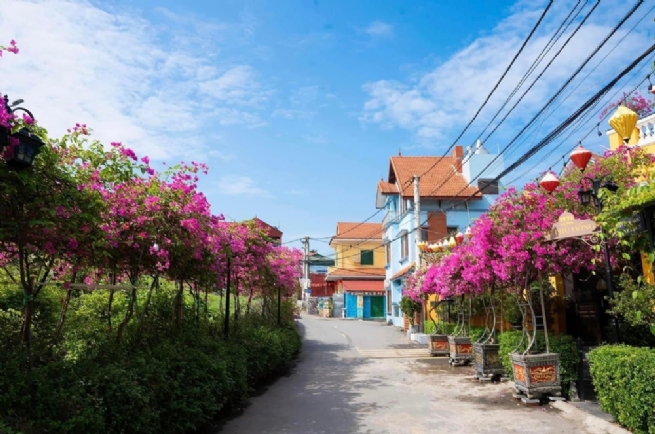Phu Dong commune is known for its special cultural and historical values. In recent years, the commune has focused on development and leveraged its inherent strengths to successfully build an exemplary new rural commune.
Phu Dong commune was established by merging several administrative units, comprising of the entire population of Yen Vien town, Yen Vien, Yen Thuong, Ninh Hiep, Phu Dong, and Thien Duc communes and part of Co Bi and Dang Xa communes.

Before the merger, all the communes had been recognized to satisfy advanced new rural development standards. Former Phu Dong, Yen Thuong, and Ninh Hiep communes were certified to meet exemplary new rural communes. Building on these achievements, new Phu Dong commune is striving to become an example in building advanced and model new rural areas linked with promoting cultural and historical values.
Dao Duc Minh, Chairman of the People's Committee of Phu Dong Commune, said: The Party and people of the commune have continuously endeavored and utilized resources for advanced and model new rural development. This effort has yielded encouraging results: The economy has grown steadily, and technical and social infrastructure has been strengthened. The commune is home to several concentrated craft villages, such as Yen Thuong, Yen Vien, Thien Duc, Ninh Hiep, and Phu Dong. It also has two famous traditional craft villages: The traditional medicine village of Ninh Giang-Ninh Hiep and the ornamental plant and bougainvillea village of Phu Dong.
Notably, Phu Dong commune is the homeland of Saint Giong, one of the “Four Immortals” in Vietnamese folk beliefs. In 2021, the Hanoi People's Committee issued Decision 4728/QD-UBND on recognition of Phu Dong tourist destination. Particularly, Phu Dong 2 village is a key destination on Phu Dong tours, connecting with other tourist sites in Hanoi, the capital of Vietnam. According to the long-term orientation on Phu Dong tourism site construction, Phu Dong 2 village is a popular destination for visitors to explore the historic Phu Dong Temple and the Giong Festival, recognized by UNESCO as a “Representative Intangible Cultural Heritage of Humanity.” Tourists can also visit garden-field models of local households. This development is also boosting local service and trade industries, creating jobs, and increasing income for rural workers. Additionally, Xuan Duc village is home to the Xuan Duc Communal House, a recognized national historical and cultural relic. Built in the Later Le Dynasty (late 16th to early 17th century), it features architectural details with strong artistic influences from the Le-Mac period and keeps valuable artifacts, including the horizontal lacquered board “My Tuc Kha Phong” (Good customs should be followed), granted by King Tu Duc in 1872. The Xuan Duc Communal House and Pagoda, along with the village's traditional festival, also attract numerous tourists.

Dang Thi Huyen, Secretary of the Party Committee and Chairwoman of the People's Council of Phu Dong Commune, stated that Phu Dong has a rich historical and cultural tradition, featured with 101 historical and cultural relics and four revolutionary resistance relics. Among them are one special national relic site (Phu Dong Temple), 19 national relics, and 30 city-level relics. Other notable relics include Xuan Duc Communal House, Phuc Nuong Pagoda, Lord Nguyen Dinh Huan Temple, Ha Thon Communal House, Nanh Pagoda, Ninh Giang Communal House and Pagoda, and Nguyen Tho Trang Temple.
Phu Dong commune is also famous for its ornamental plant and bougainvillea cultivation, which was officially recognized as a craft village in 2020. The bougainvillea village was established more than 20 years ago and has become the main occupation for locals. Flower-growing households have significantly improved their income and living standards.
Visitors to the Phu Dong bougainvillea village can participate in hands-on experiences, such as tending, nurturing, and pruning various flowers and ornamental plants, to appreciate the meticulousness, diligence, skill, and patience of Phu Dong residents in creating high-quality artistic and aesthetic works.

Phu Dong commune currently has many businesses, households, and individuals running successful tourism models like garden-field, experiential tours, and garden houses. These models generate hundreds of millions to billions of dong annually. Many of these models, such as Phu Dong Green Park Joint Stock Company, Ngoc Thu Garden House, and Huy Trang Garden House, attract many visitors.
Entering the ascending era of the nation, Phu Dong commune has set a long-term vision to effectively mobilize and utilize investment resources for green, sustainable development. The commune is focusing on developing concentrated, high-tech, and clean industrial clusters and logistics services. It also plans to establish cultural complexes, ecological parks, entertainment areas, and green spaces along the Duong River; preserve the natural landscape; and develop ecological urban agricultural tourism and experiential tourism. At the same time, the locality will continue to preserve and promote the value of cultural heritage while developing the cultural industry and positioning its tourism brand to match the value of its national and global heritage sites, said Huyen.
By Dinh Bao, Vietnam Business Forum
|
This special section is supported by Hanoi Coordination Office of the New Rural Development Program |